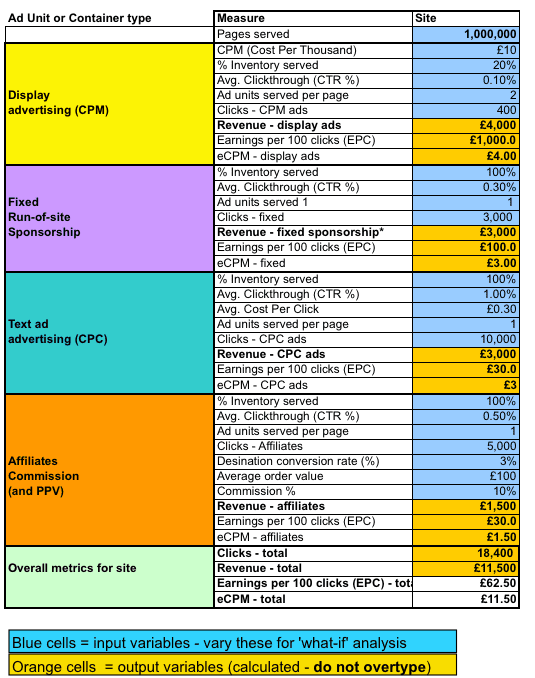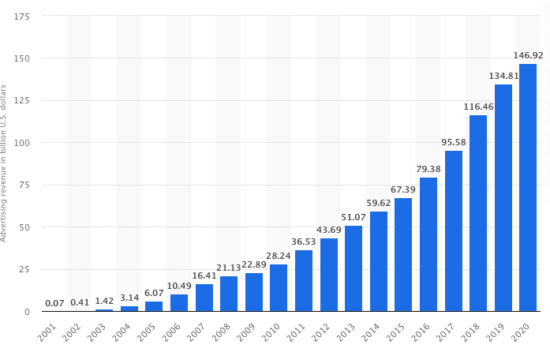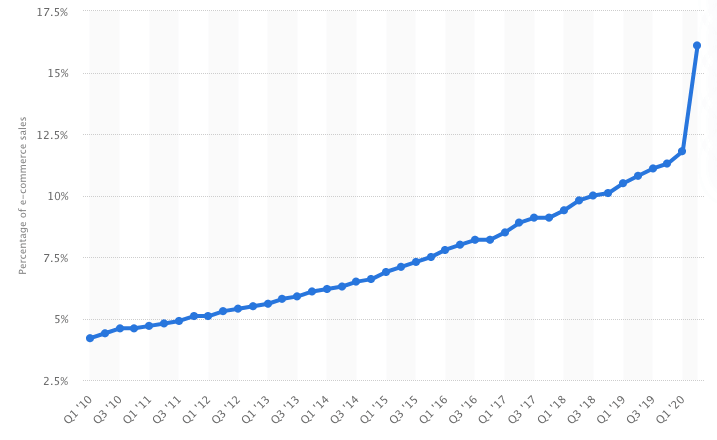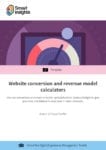Selecting the best revenue model options for your digital business
A good revenue model is a proven technique used by digital businesses globally, from startups to global corporations, to generate income from traffic on their website, mobile apps, and via digital channels.
The 10 digital revenue model options explained in this include both ad revenue models and charging for access to a digital service including freemium revenue models where limited free access is provided with fees charged for the full service.
I created this post originally in 2010 to support a revenue model spreadsheet for site owners to forecast their revenue generation. The main parameters you need to set are the variables for each Ad Unit or Container Type (blue fields) and it works out the revenue earning (orange fields) for you!
The site ad revenue model
If you 'plug-in' some average figures for pay-for-performance-based advertising options like cost per click or cost per action approaches, as shown below, it shows why fixed fees and CPM models tend to be preferred by publishers.
It also shows that you need substantial traffic to make a lot of money through advertising. At a CPM Of £10 with 2 ad units on the site, you would make just £4,000 per month even with a million page views per month for which you serve paid ads to 20% of the audience. Set this to 100% if you are selling all your ad inventory, for example through Google Adsense.

To use this model and different Internet site revenue models to calculate income potential use our online revenue model spreadsheet - see Ad Revenue model worksheet. This includes a range of Internet planning models including a way of assessing Internet revenue sources - this is on worksheet 3.
Download Business Member Resource – Website conversion and revenue model calculators
Use our conversion and revenue model spreadsheets to create a $, £ or € based budget to give you more confidence in your lead or sales forecasts. Contains 4 worksheets including the digital ad revenue options shown here.
Access the Website conversion and revenue model calculators
How to use the revenue calculator
This spreadsheet can also be used by owners of existing sites like publishers to estimate ad or affiliate marketing revenue from a site or section of the site.
It allows these parameters to be set:
- % inventory - the proportion of ad space sold on sites
- Number of ad units
- CPM - Cost per thousand impressions for ad volume deals
- CPC - Cost Per Click for Pay Per Click Deals
Total revenue for each ad unit or container and corresponding Earnings per 100 clicks (EPC) or Earnings per thousand page views (eCPM) is calculated automatically.
The limitation of the model is that it assumes the same model across the whole site. It would be straightforward to modify it for different sections.
10 revenue models for your business
For a publisher or other media site owner, I identify eight types of revenue models, which are possible online.
Of course, transactional sites have the option of these also in addition to sales - online, everyone is a media owner.
1. Revenue from subscription access to content
A range of documents can be accessed for a month or typically a year.
For example, I subscribed to FT.com for access to the digital technology section for around‚ £80 per year a few years ago. Smart Insights members have an annual subscription in this form.
Publishers often use a freemium revenue model where subscribers gain free access to a limited number of sample articles or downloads, but this is limited or metered. This is a common approach on newspaper publishers today which may restrict to 3 articles per month for example.
Smart Insights have a freemium model with free membership for access to 20+ sample download templates but paid subscription for access to all templates and e-learning.

2. Revenue from Pay Per View access to documents
Here payment occurs for single access to a document, video, or music clip that can be downloaded. It may or may not be protected with a password or Digital Rights Management. Smart Insights monthly subscription is effectively PPV since members are limited to 5 downloads per month (otherwise they could download 100s of resources potentially).
For example, I've paid to access detailed best practice guides on Internet marketing from Marketing Sherpa.
Digital rights management (DRM) is the use of different technologies to protect the distribution of digital services or content such as software, music, movies, or other digital data.
3. Revenue from CPM display advertising on site
(e.g. banners ads and skyscrapers).
CPM stands for "cost per thousand" where M denotes "Mille". The site owner such as FT.com charges advertisers a rate card price (for example £50 CPM) according to the number of its ads shown to site visitors.
Ads may be served by the site owner's ad server or more commonly through a third-party ad network service such as Google AdSense as is the case with my site.
For marketers looking to get into display ads, they will need to look internally first at the most successful journeys on their site before deciding where to scale up. Our resources help marketers identify and prioritize winning marketing activities to quickly escalate customer paths to purchase.

4. Revenue from CPC advertising on site (pay per click text ads)
CPC stands for "Cost Per Click". Advertisers are charged not simply for the number of times their ads are displayed, but according to the number of times, they are clicked. These are typically text ads similar to sponsored links within a search engine but delivered over a network of third-party sites on a search engine such as the Google Adsense Network.
Typical costs per click can be surprisingly high, i.e. they are in the range £0.10 to "‚ £4, but sometimes up to £40 for some categories such as "life insurance" that have a high value to the advertiser.
The revenue for search engines or publishers from these sources can also be a fair proportion of this. Last year, Google made US $146.92 bn in advertising revenue.

For me, Google's content networks are one of the biggest secrets in online marketing with search engines such as Google generating over a third of their revenue from the network, but some advertisers not realizing their ads are being displayed beyond search engines and so not served for this purpose.
Google is the innovator and offers options for different formats of ad units including text ads, display ads, streamed videos and now even cost per action as part of its pay-per-action scheme.
5. Revenue from sponsorship of site sections or content types (typically fixed fee for a period)
A company can pay to advertise a site channel or section. For example, bank HSBC could sponsor the Money section on a media site. This type of deal is often struck for a fixed amount per year. It may also be part of a reciprocal arrangement, sometimes known as a "contra-deal" where neither party pays.
A fixed-fee sponsorship approach was famously used by Alex Tew in 2005, a 21-year-old considering going to University in the UK who was concerned about paying off his university debts. This is no longer a concern since he earned $1,000,000 in 4 months when he set up his Million Dollar Homepage.
His page was divided into 100-pixel blocks (each measuring 10x10 pixels) of which there are 10,000 giving 1,000,000 pixels in total. Alex spent £50 on buying the domain name (www.milliondollarhomepage.com) and a basic web-hosting package. He designed the site himself but it began as a blank page.
6. Affiliate revenue (CPA, but could be CPC)
Affiliate revenue is commission-based, for example, I display Amazon books on my personal blog site DaveChaffey.com and receive around 5% of the cover price as a fee from Amazon. Such an arrangement is sometimes known as Cost Per Acquisition (CPA).
Increasingly, this approach is replacing CPM or CPC approaches where the advertiser has more negotiating power. However, it depends on the power of the publisher who will often receive more revenue overall for CPM deals. After all, the publisher cannot influence the quality of the ad creative or the incentivization to click which will affect the Clickthrough rate on the ad and so the CPM.
Of course, when advising marketers who are looking for affiliates, we don't recommend getting involved in advanced distribution of your content before you have a funnel that works. We have resources to support all customer journeys and help you communicate your value proposition.

7. Subscriber data access for e-mail marketing
The data a site owner has about its customers is also potentially valuable since it can send different forms of e-mail to its customers if they have given their permission that they are happy to receive an e-mail either from the publisher or third parties. The site owner can charge for adverts placed in its newsletter or can deliver a separate message on behalf of the advertiser (sometimes known as list rental). A related approach is to conduct market research with a site's customers.
8. Access to customers for online research
Considering all of these approaches to revenue generation together, the site owner will seek to use the best combination of these techniques to maximize the revenue. To assess how effective different pages or sites in their portfolio are at generating revenue, they will use two approaches. The first is eCPM or effective Cost Per Thousand.
This looks at the total they can charge (or cost to advertisers) for each page or site. By increasing the number of ad units on each page this value will increase. This is why you will see some sites which are cluttered with ads. The other alternative to assess page or site revenue-generating effectiveness is Revenue per click (RPC), which is also known as Earnings Per Click (EPC).
This is particularly important for affiliate marketers who make money through commission when their visitors click through to third-party retail sites such as Amazon and then purchase products.
Considering other ad revenue models we can cover the full top 10 ad revenue models for digital businesses with the final options. Some publishers now offer these as well, although more typically by an affiliate arrangement.
9. Online e-commerce sales transactions
This needs no introduction - these are where products are sold online and dispatched and have seen rapid growth rates in % of online sales.

10. Online digital service subscriptions for physical goods
These take two forms:
- Digital subscription to a digital service hosting digital assets like music or video. For example, Spotify, Apple Music or Netflix.
- Digital subscription to a physical delivery - these may be dedicated services for food (e.g. Graze or Simply Cook) or linking back to option 9. For example Amazon have their 'Subscribe and Save' option which other retailers have looked to emulate.
To find out more about each type of revenue model mentioned above, or to start calculating how your business can benefit from these techniques, download our Website conversion and revenue model calculators today.
Download Business Member Resource – Website conversion and revenue model calculators
Use our conversion and revenue model spreadsheets to create a $, £ or € based budget to give you more confidence in your lead or sales forecasts. Contains 4 worksheets including the digital ad revenue options shown here.
Access the Website conversion and revenue model calculators











